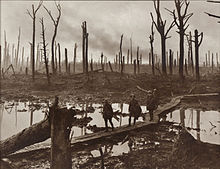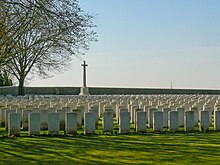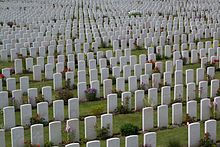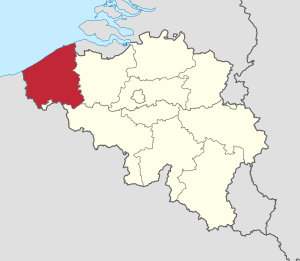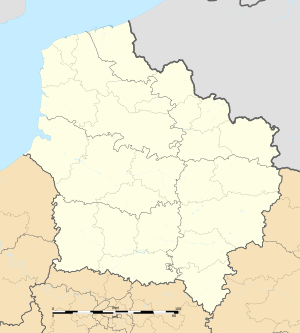Battles of Flanders
The four great battles of Flanders in 1914, 1915, 1917 and 1918 in French Flanders and in Belgian Flanders ( Westhoek ) were among the most important battles on the Western Front of the First World War . In particular, the Third Battle of Flanders in 1917 was comparable to the Battle of the Somme in terms of extent and casualty figures and occupies a special place in the cultural memory of Great Britain and its former Dominions . In the battles the German army faced troops from the aforementioned countries as well as from France , Belgium and Portugal or the colonies. The fights took place in the so-called Wytschaete-Bogen, among other things, for the high terrain of Messines and Wytschaete or for the Kemmelberg . These strategic positions should be used to achieve the respective goals - on the German side the destruction of the base of operations and the shutdown of the supply ports of the British Expeditionary Force (BEF), on the British side, among other things, the neutralization of the German submarine bases on the Flemish coast - to realize and thus to gain a decisive advantage.
overview
First Battle of Flanders in 1914
The First Battle of Ypres lasted from 20 October to 18 November 1914 and came directly from the after the Battle of the Marne incipient race to the sea . The Entente troops succeeded in repelling the German breakthrough attempts aimed at the French canal ports ( Calais , Dunkerque , Boulogne , etc.). The German side remembered the alleged "sacrifice" of young volunteers at Langemark , which gave rise to the Langemarck myth . On the British side, the “end of the old BEF” was viewed as a bad omen - statistically, each of the original 80,000 BEF soldiers had been sidelined by the end of the battle due to death, wounding or capture. Even British-Indian troops who had just arrived in Europe were thrown into the fighting.
The front stabilized in front of Ypres , which was also fiercely fought over in the following years. The famous medieval cloth halls of the Belgian city were bombarded with artillery by the Germans on November 3, 1914 and burned down, which caused international outrage and was perceived as part of a campaign against the Belgian national consciousness. (For background, see Rape of Belgium and War Aims in World War I. )
Second Battle of Flanders, 1915
The Second Battle of Flanders began on April 22nd and lasted until the end of May 1915. It is mainly remembered for the first massive use of poison gas (in this case chlorine gas ) on the Western Front, which gave the attacking Germans a great advantage, but ultimately not was decisive in the battle. For the first time in this battle troops of the Canadian Expeditionary Force were used in the division . They made a major contribution to repelling the German attack.
The gas was first used on April 22, 1915. It was blown from pressure bottles and released a deadly cloud of poison into the French trenches over a six-kilometer stretch. Many of the soldiers died of chemical burns to their lungs, and thousands suffered serious injuries.
Third Battle of Flanders, 1917
The Third Battle of Flanders from July 31st to November 6th 1917 with its prelude, the Battle of Messines in June, was one of the greatest battles of the entire war. Overall, fell within 100 days over 600,000 men on both sides by death, injury or other causes out of which 250,000 men were fallen .
The Belgian village of Passendale (English Passchendaele ) gave the battle its English name, which to this day stands for the horrors of war. The allies on the offensive conquered a territory of around 130 square kilometers in the area softened by constant rainfall, without achieving any decisive success. In this battle soldiers from all British Dominions were in action, the " ANZACS " and the Canadian Corps led by Arthur Currie particularly distinguished themselves.
Fourth Battle of Flanders, 1918
The Fourth Battle of Flanders from April 9 to 29 was part of the German spring offensive in 1918 and is one of the last attempts on the German side to break the stalemate of the trench warfare . It followed the Michael Offensive in the Somme area and temporarily brought the territory back to the Germans that had been lost the previous year. However, the attack got stuck several kilometers from the important British supply depot in Hazebrouck . In the further course of the year the Allies took the initiative again and finally wrested the area from the Germans. The Portuguese Expeditionary Force was also used in this battle .
Aftermath and commemoration
Even a hundred years after the start of World War I, there are still remains of ammunition in the vicinity of the Belgian city of Ypres. In March 2014, for example, two construction workers died when a grenade exploded from that period. The detonation occurred on an industrial site. In addition to duds, there are also numerous canisters with the deadly poison gas, which are rendered harmless by a special unit of the Belgian army.
War graves and memorials
Numerous war cemeteries in the area around Ypres commemorate those who died in the fighting. Sometimes the graves of the fallen on both sides are in the immediate vicinity or the dead on both sides are in the same cemetery. Mention may be made about the German side of the German War Cemetery Langemark ( ⊙ ) with around 44,300 deaths in single and mass graves, the German War Cemetery Menen ( ⊙ ) with 47,900 dead, the German military cemetery Vladslo ( ⊙ ) with more than 25,600 dead and the German military cemetery Hooglede ( ⊙ ) with over 8,200 dead, on which most of the around 134,000 German war dead in Belgium were reburied after the German-Belgian war graves agreement of 1954.
On the British side, the Menin Gate ( ⊙ ) and the Ypres Town Cemetery and Extension ( ⊙ ) in Ypres, the Tyne Cot Cemetery and Memorial to the Missing ( ⊙ ) near Passendale and the Zantvoorde British Cemetery ( ⊙ ) near Zonnebeke are reminiscent of these , several smaller cemeteries near Brandhoek ( ⊙ ), the Essex Farm Cemetery ( ⊙ ) near Ypres, the Lijssenthoek Military Cemetery ( ⊙ ) near Poperinge , the Maple Copse Cemetery ( ⊙ ), the Prowse Point Military Cemetery ( ⊙ ), the Polygon Wood Cemetery ( ⊙ ), the Buttes New British Cemetery and New Zealand Memorial ( ⊙ ) at Zonnebeke, the Hooge Crater Cemetery ( ⊙ ) and the Bedford House Cemetery ( ⊙ ) to the battles and their dead. The Anglican Church of St. George's Memorial Church in Ypres holds a special memorial service every year on Armistice Day (November 11th). A special tradition is playing the horn signal The Last Post every evening at Menin Gate in Ypres in memory of the dead of the Commonwealth. This was only interrupted during the German occupation of Belgium in World War II.
Most of the French who died in the battles of Flanders were reburied after the war in the French National Cemetery Notre-Dame-de-Lorette ( ⊙ ) near Ablain-Saint-Nazaire , which thus became the central French memorial for the northern battlefields from the Artois to the Belgian coast. It houses the remains of over 43,000 fallen. In the immediate vicinity of was in the 2010s with the support of the French Ministry of Defense , the favor memorial Notre-Dame-de-Lorette ( ⊙ ) built (also ring memory ). 500 metal steles in the interior list the names of almost 580,000 fallen in northern France of all nationalities in alphabetical order, without any reference to their rank, origin or religion. The only major French military cemetery in Belgium (apart from the Ossuaire du Mont Kemmel ossuary on the Kemmelberg) is called Saint-Charles de Potyze and is located near Wieltje .
A monument in La Couture and the Portuguese National Cemetery in neighboring Richebourg commemorate the Portuguese fallen in the Fourth Battle of Flanders .

In Flanders Fields
The poem In Flanders Fields by the Canadian medical officer John McCrae (1872-1918), who had written it in 1915 in memory of a comrade who fell in the Second Battle of Flanders, achieved particular fame .
The poppy mentioned in it is a symbol of the dead in the fighting and was the starting point for the remembrance poppies, which is widespread in English-speaking countries . On the German side, a similar symbol was created with a stylized forget-me-not , which has references to the Blue Flower of Romanticism and thus to the Wandervogel movement of the early 20th century.
Museums
In Diksmuide of around 84 meters high houses Ysertower ( IJzertoren ) on 22 floors, a museum about the First World War in Flanders. Other museums that deal with this part of history are the “ In Flanders Fields Museum ” in Ypres and the “Memorial Museum Passchendaele 1917” in Zonnebeke .
Artworks (gallery)
After The Push
Christopher RW Nevinson , 1917The Ypres Salient at Night
Paul Nash , 1918The Menin Road
Paul Nash, 1919
See also
- Battle for Height 60 (Western Front)
- Height 80
- Mine warfare in World War I
- Yser front
- Marine Corps Flanders
- Zone rouge
literature
- Beatrix Brice: The Battle Book of Ypres: A Reference to Military Operations in the Ypres Salient, 1914-1918. John Murray Publishers, Spa Books in association with Tom Donovan Military Books, 1987, ISBN 0-907590-17-9 , (first edition 1927, excerpt ).
- Yves Buffetaut: Batailles de Flandres et d'Artois 1914–1918 (= guides “Historia”. 11). Editions Tallandier, [Paris] 1992, ISBN 2-235-02090-9 .
- Winston Groom: A Storm in Flanders: Triumph and Tragedy on the Western Front. Weidenfeld & Nicolson, London 2016, ISBN 978-1-4746-0434-5 ( reading sample ).
- Mélanie Morin-Pelletier: Fighting in Flanders: Gas, Mud, Memory. Canadian Museum Of Civilization, Ottawa, ON 2015, ISBN 978-0-660-20306-5 .
- Alan Palmer : The Salient: Ypres, 1914-18. Constable, London 2007, ISBN 978-1-84119-633-6 .
- Werner Bernhard Sendker: Fallen in Flanders' Fields: Germans and their Relationship to the First World War. Der Andere Verlag, Tönningen 2005, ISBN 3-89959-366-9 .
- Keir Reeves, Geoffrey R. Bird, Laura James, Birger Stichelbaut and Jean Bourgeois (eds.): Battlefield Events: Landscape, commemoration and heritage. Routledge advances in event research series, 2016, ISBN 978-1-138-90059-2 . In it u. a .:
- Caroline Winter: Celebrating peace and commemorating war in the city of Ieper. (Pp. 77-94).
- Luc Vandael, Hannelore Decoodt, Marc Dewilde, Piet Geleyns, Koen Himpe, Marnix Peters and Hilde Verboven: The Heritage of 'Flanders Fields'. Research, protection, management and commemoration of World War I landscapes in Flanders (Belgium). (Pp. 95-108).
Web links
- Jones Spencer: Ypres, Battles of In: Ute Daniel, Peter Gatrell, Oliver Janz, Heather Jones, Jennifer Keene, Alan Kramer, and Bill Nasson (Eds.): 1914-1918-online . International Encyclopedia of the First World War, Freie Universität Berlin, Berlin February 13, 2015, doi: 10.15463 / ie1418.10552 (English).
- BeCarto 14-18 website with interactive map (multilingual)
- Battles Ypres Salient on wo1.be (English)
- Battle Sites in Belgium on the website webmatters.net (English)
Footnotes
- ^ Allan Mallinson: 1914: Fight the Good Fight: Britain, the Army and the Coming of the First World War. Random House, 2013, ISBN 978-0-593-06760-4 , pp.?
- ↑ Thomas Weißbrich: The Battle of Ypres 1915. Deutsches Historisches Museum, Berlin, September 1, 2014, accessed on April 11, 2017 .
- ↑ One battle - 250,000 dead In: First World War - Flanders Fields ( deutschlandradiokultur.de from August 13, 2014)
- ^ Sven Felix Kellerhoff: Battles of Flanders. The First World War is always present in Ypres. In: Die Welt Online. March 21, 2014, accessed April 11, 2017 .
- ↑ Langemark , Menen , Vladslo and Hooglede on the pages of the Volksbund Deutsche Kriegsgräberfürsorge , accessed on April 11, 2017.
- ^ The Ypres Salient ( Memento of May 9, 2017 in the Internet Archive ) on the pages of the Commonwealth War Graves Commission , accessed April 11, 2017.
- ↑ Monuments & Memorials on the Ypres Salient, Belgium on the website greatwar.co.uk , accessed April 11, 2017.
- ↑ Notre-Dame-de-Lorette International Memorial at cheminsdememoire.gouv.fr , accessed on April 13, 2017.
- ↑ De Franse militaire begraafplaats Saint-Charles de Potyze by Philippe Barbez on wo1.be (Dutch), accessed on April 15, 2017.
- ↑ Richebourg - Portuguese Cemetery on wegedererinnerung-nordfrankreich.com , accessed on April 14, 2017.
- ↑ In Flanders Fields ( English, French ) In: The Canadian Encyclopedia . Retrieved July 28, 2019.
- ↑ The Ijz Tower. museumaandeijzer.be, accessed on April 11, 2017 .
